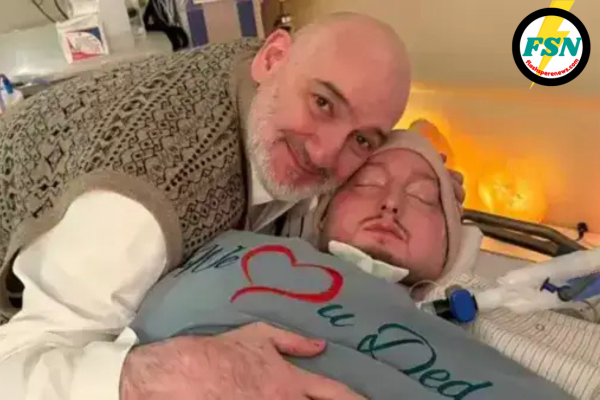The Heartbreaking Farewell to Saudi Arabia’s Sleeping Prince: A Nation Mourns the End of a 20-Year Vigil

In a deeply emotional moment for the Kingdom, the prolonged silence surrounding Saudi Arabia’s Sleeping Prince has come to a solemn close. After two decades in a coma, Prince Al-Waleed bin Khalid Al-Saud passed away, drawing to an end one of the most poignant stories in the modern history of the House of Saud. Revered by his people, mourned by millions, and remembered as a symbol of endurance, the prince’s life—largely lived in silence—continues to stir hearts around the world.
The news of the death of Saudi Arabia’s Sleeping Prince was confirmed by family sources and soon echoed across global media, reigniting a wave of compassion and curiosity about the extraordinary journey of the young royal. This moment not only marks the end of a chapter but also opens up an emotional dialogue about the fragility of life, the power of familial love, and the collective patience of a nation.
The Tragic Event That Changed Everything
The life of Saudi Arabia’s Sleeping Prince was abruptly altered in 2005 when a devastating car accident left him in a coma. A student at a military academy in the United Kingdom at the time, Prince Al-Waleed’s accident resulted in severe brain trauma. Despite being declared in a vegetative state, his family never gave up hope. For 20 long years, they prayed and waited, keeping the spirit of optimism alive.
Throughout this period, his room became a shrine of love and optimism. Regularly visited by relatives, including high-profile members of the royal family, the prince was never left alone. His story became a symbol of perseverance and unwavering familial dedication. As the years passed, the tale of Saudi Arabia’s Sleeping Prince became legendary across the Middle East, symbolizing both tragedy and the unbreakable bond of family.
Prince Al-Waleed was young, filled with promise, and on the cusp of assuming future responsibilities that many in the royal family prepare for from birth. His accident, therefore, was not only a personal family tragedy but also a blow to the nation’s collective aspirations. His potential, frozen in time, became a haunting reminder of what could have been.
As medical advancements continued and healthcare evolved, the family spared no expense in offering the best treatment options. Specialists were flown in, experimental therapies explored, and alternative treatments considered. The family of Saudi Arabia’s Sleeping Prince held on to every glimmer of hope, every twitch or reaction, no matter how minor. These moments, though fleeting, were the source of spiritual reinforcement.
Global Curiosity and Empathy for Saudi Arabia’s Sleeping Prince
As the world watched, news about Saudi Arabia’s Sleeping Prince circulated far beyond the borders of the Kingdom. International figures sent messages of support, and his name trended on social media platforms multiple times during the last two decades. Videos occasionally released by his father showed minimal but hopeful responses to stimuli, such as finger movements or slight head turns, sparking debates among neurologists and giving the family reason to hope.
The story resonated with many people who had experienced similar circumstances—those caring for loved ones in comas or suffering from severe disabilities. Forums and blogs dedicated entire sections to the tale of Saudi Arabia’s Sleeping Prince, exchanging notes on treatment options, emotional support, and coping mechanisms.
There was something universally human in the family’s commitment—a father who wouldn’t let go, a family that refused to surrender to statistics, and a nation that collectively held its breath for two decades. Unlike most news stories that come and go, the prince’s condition was a continuous narrative, marked by emotional depth, scientific debate, and spiritual questioning.
The Last Goodbye: A Nation in Mourning
The funeral of Saudi Arabia’s Sleeping Prince was held with the reverence and decorum befitting a royal figure. Crowds gathered in Riyadh as prayers were offered for the departed soul. Members of the House of Saud, alongside diplomats and international guests, paid tribute to a life lived mostly in silence but surrounded by love.
Condolences poured in from across the globe. The people of Saudi Arabia, who had followed his story for years, felt the loss deeply. To them, Saudi Arabia’s Sleeping Prince was not just a member of the royal family; he was a symbol of hope and faith in the face of unimaginable challenges. Mourning took on many forms: from public gatherings to private prayers, from newspaper tributes to digital memorials.
In various cities and towns across the Kingdom, citizens observed moments of silence. National television channels aired documentaries recounting his life and the unwavering devotion of his family. The passing of Saudi Arabia’s Sleeping Prince united the nation in sorrow and reverence.
The Devotion That Touched Millions
Perhaps what captivated the world most about Saudi Arabia’s Sleeping Prince was the relentless devotion of his family. His father, Prince Khalid bin Talal, refused to accept medical prognoses that dismissed the possibility of recovery. He ensured that his son received constant care, modern treatments, and spiritual support.
The prince’s hospital room was never neglected, always tended to with precision and love. Qur’anic verses were recited regularly. Physiotherapy was administered, even in the absence of motor response. Aromatherapy, audio therapy, and tactile stimulation were used in rotation. No method was too obscure or expensive. To the family of Saudi Arabia’s Sleeping Prince, every second counted, every heartbeat was sacred.
The unwavering belief of the family soon transcended the borders of Saudi Arabia. Across the Arab world and beyond, he became a figure of shared mourning and hope. The story was passed down to new generations, embedded into cultural narratives and collective memory.
Spiritual leaders, religious scholars, and imams would often mention Saudi Arabia’s Sleeping Prince in sermons, urging people to practice gratitude and patience. His life inspired not only royal admiration but also grassroots respect.
Saudi Arabia’s Collective Grief and Emotional Connection
In the days following the prince’s passing, public spaces and media outlets across the Kingdom expressed collective sorrow. Mosques hosted special prayers, and schools paused to reflect on the legacy of Saudi Arabia’s Sleeping Prince. His image—peaceful, dignified—was displayed in homes and public squares, becoming a reminder of love, hope, and resilience.
The prince’s story resonated on a deeply emotional level. He became more than a figure in a coma; he was a symbol of a nation’s capacity for love and endurance. During holidays and religious observances, many remembered him in their prayers. His presence was subtly felt in national discourse, artistic tributes, and even policy discussions on long-term medical care.
Social media flooded with tributes—poems, photographs, edited videos, and collages that chronicled his two-decade-long journey. Many users adopted his image as profile pictures in solidarity. Others shared personal stories of loved ones who had endured similar fates. In all these ways, Saudi Arabia’s Sleeping Prince lived on in the hearts of millions.
The Global Medical and Ethical Conversation

The story of Saudi Arabia’s Sleeping Prince sparked global discussions on medical ethics, coma care, and familial loyalty. Across Europe, Asia, and the Americas, his case was studied in universities and medical forums. How long should a family wait? What defines quality of life? These were not merely philosophical questions but daily realities for the prince’s caregivers.
In several medical journals, his condition became a focal point for papers exploring prolonged coma management, the effects of long-term artificial ventilation, and the psychological toll on family members. Debates flourished regarding ethics, autonomy, and medical futility.
Yet through it all, Saudi Arabia remained steadfast. The Kingdom’s approach, grounded in faith and emotional resilience, stood in contrast to Western pragmatism. This divergence prompted many to rethink their values and question their assumptions about life and dignity.
Documentaries were made, conferences held, and non-profit organizations cited his story as a benchmark of familial sacrifice. The case of Saudi Arabia’s Sleeping Prince elevated medical discussions into the moral and spiritual realms, making it a subject of universal reflection.
A Legacy That Endures Beyond Life
Today, as we look back at the life and legacy of Saudi Arabia’s Sleeping Prince, we are reminded that impact is not always measured in words spoken or deeds done. Sometimes, simply enduring becomes a powerful form of expression.
Prince Al-Waleed bin Khalid Al-Saud never ruled, never gave a public speech, and never signed a royal decree. Yet, he managed to touch lives across the globe through his silent journey. He has left behind a legacy of love, one that will endure in the hearts of millions.
Plans are already in motion for charitable initiatives and medical endowments in his name. These will support families undergoing similar experiences and promote ethical medical care. Memorial parks, art installations, and scholarships are expected to be announced in the coming months—all dedicated to Saudi Arabia’s Sleeping Prince.
Closing Reflections: A Prince Who Reigned in Silence
As Saudi Arabia says farewell, the world joins in a collective moment of reflection. The 20-year saga of Saudi Arabia’s Sleeping Prince was more than a medical case—it was a story of love, human spirit, and unyielding faith. His name will live on, etched not just in royal archives but in the emotional memory of a nation and the global community.
He taught us all that even in silence, there is a voice. Even in stillness, there is power. And even in loss, there is love. May he rest in peace, and may his story continue to inspire humanity across the world.

